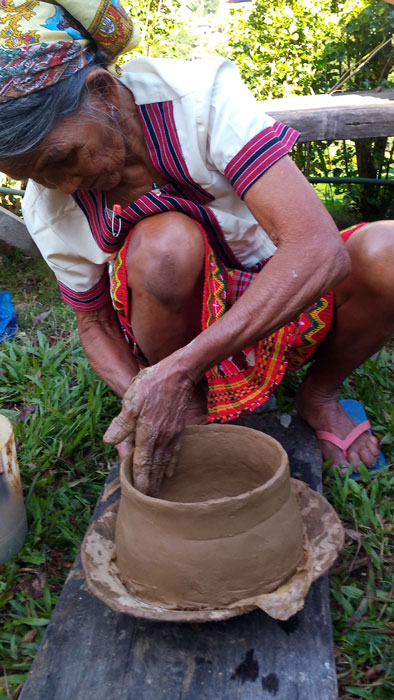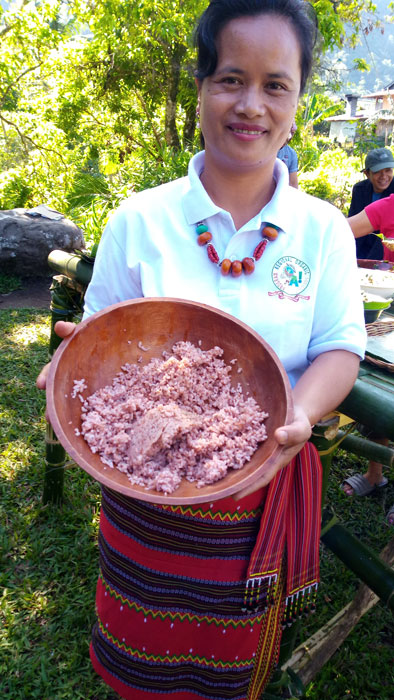A Village Called Dangtalan
/Dangtalan pottery at the Mangan Taku food festival held in Baguio City (Photo by Lourdes Guieb-Demetillo)
Kabunian, god of the sky-world, walked from the town of Paracelis in Mountain Province to Dangtalan and arrived hungry, but found there were no pots or utensils to cook with. He thus dug the soil and made a pot and cooked himself his meals for three days. The village women peeked from behind bushes and, amazed by what they saw, thereon imitated how Kabunian made a pot from clay. Kabunian then moved on to the western part of Pasil to Mt. Galdang, and feeling thirsty, struck a rock from where water gushed forth. It remains a mystical rock, sometimes called Batong Buhay, as it shows no crack except where the water springs forth.
Almost every villager knows the story by heart, passed on down generations, a reflection of how closely they have lived with their traditions and way of life.
To this day, Dangtalan is known for its pottery, done with no potter’s wheel but shaped with bare hands from a ball of clay and further refined with a paddle and anvil.
“Here in Dangtalan, elders simply say God gave their ancestors the gift and the power to do something out of their clay”
In 1973, Dangtalan caught the attention of anthropologists who then embarked on the Kalinga Ethnoarchaeological Project, focused on the pottery culture. Led by University of Arizona Professor William Longacre, the project lasted for almost 20 years, and Longacre became accepted as a native.
The probe into the traditional pottery led into interesting historical finds beyond just the ancient craft.
Ellen Malannag, a respected figure in the village and recognized as a matriarch of the community, said that way back before Longacre came to their place, her father by chance dug up an old porcelain jar with a small plate inside. When they lifted the plate out of the jar, it crumbled into pieces, perhaps because of exposure to air. “Longacre said it belongs to the Ming dynasty of China when I showed it to him,” Malannag said. Other Chinese ancient jars have also since been dug up in the area.
Like some ancient skills in the Cordillera region and perhaps among other indigenous groups, just how the craft was first learned by their ancestors remains unknown, except for a legend. Here in Dangtalan, elders simply say God gave their ancestors the gift and the power to do something out of their clay.
Pottery has just always been a part of life, a tradition to sustain daily living and as a trade commodity with other villages. There are clay pots for storing water, cooking rice, another for vegetables and others for meat.
Malannag said that Longacre mentions in his writings that the Dangtalan clay is of the best quality in the Southeast Asian region. Longacre’s book on the study, with its personal dedication to Malannag, makes the rounds among the curious in the community and she can’t say at any given time just where it is.
But the community acknowledges that their resource is not limitless. The place where the clay is dug up now has a big hole and they know it’s time to stop digging deeper and wider. Another privately owned lot is being eyed and under talks at the moment. It’s part of the cultural value of respecting nature that the community upholds.
Malannag, a former schoolteacher, also sees to it that the craft is taught early in school. “It’s the pride of our people that must not be forgotten,” she says.
The Long Road to Dangtalan
It was the Cordillera Department of Tourism that brought the group of journalists to Dangtalan under its culinary journey project as a way to get to know the culture of the ethnic groups in the Cordillera. One wondered if the trip -- on never-ending winding roads, past landslides and roads half-eaten by erosion -- would ever come to an end, only to be surprised by an unexpected grand welcome by the village upon arrival at night.
A program of tribal songs and dances, performed by the youngest grade schoolers, the “teen” group, and the seniors dressed in tribal fineries was delightful. Everyone spoke fluent English. The highlight was the “banga” (pot) dance, where the ladies swayed to a beat with as much as ten pots balanced on their heads.
The 'banga' dance of Dangtalan women performed during the Mangan Taku food festival in Baguio City (Photo by Lourdes Guieb-Demetillo)
There was a feast laid out, and it seemed the whole community was there to watch. Everybody danced to recorded beats of ganzas as town officials said they had recently lost a member of the community and it was forbidden to play the real ganzas for a year as a way of mourning.
It was but a clue to just how closely knit the community was and the way they managed their affairs admirably that unfolded as the hours went by.
Slow Food Movement of Pasil
There was a breakfast feast again in the morning, and the women, who traditionally make the pots, came dressed in their tribal weaves to show their guests how clay pots were made.
The star of the show was the pride of the village, 85-year-old Com-as Sangga, the oldest of the pot makers. She shaped a lump of clay into a ball, and fascinated all those around as her expert paddling of it soon made it into a pot, etched with designs. The soft pot was then fired under stacks of dried rice stalks and while hot was rubbed with lebu, the resin from almaciga trees, to seal its porousness, and finally polished with a particle from the heart of a rock.
Com-as Sangga about to make s pot from a lump of clay. (Photo by Lourdes Guieb-Demetillo)
Com-As Sangga oldest Dangtalan potter shaping the pot. (Photo by Lourdes Guieb-Demetillo)
82 year-old potter Com-as Sangga holds pot she has just made (Photo by Lourdes Guieb-Demetillo)
Ways of keeping the community intact are still observed, such as women making clay pots together and men gathering the clay from the source.
There are also some indigenous recipes prepared for special occasions that are prepared by the women such as the innallagupa, a dish wrapped in big leaves called la-u.
Dangtalan with a population of 500 may seem too remote and too small a village to be on the international scene. But Pasil is a part of the European Slow Food Movement. Its heirloom rice has been given distinction in Turin, Italy, as proof of its commitment to the movement.
Rowena Gonnay, focal person on the agriculture of Pasil, explained that the slow food movement is a way of life they are espousing in the municipality, as this touches on other aspects like the environment, health, and farming practices.
Rowena Gonnay with heirloom rice (Photo by Lourdes Guieb-Demetillo)
Slow food movement is a European concept to counter the ills of fast economies. But listening to Gonnay, a member of the European movement, slow food is really a take-off from how they live life in their town - listening to nature, life activities attuned to the seasons, organic farming, walking to anywhere within the community, traditional wisdom on healing plants and a community that knows one another.
Pasil is a 5th class municipality, but it has its own wealth in many respects, something that young Pasil mayor, Alfredo Malannag Jr, knows how to value. While he believes in tourism-driven progress, he says that slow movement also means getting there slowly to avoid the perils of commercial tourism. We have to be ready with a design that protects the culture and the environment, he says.
Mayor Alfredo Malannag, Jr. (Photo by Lourdes Guieb-Demetillo)
He is wary of unplanned tourism that may bring about the deluge of tourists and the accompanying decadence that it may bring. He realizes how small communities infiltrated by outside influences without good preparation can become a place of air and water pollution and turn their pristine environments into a plastic society in more ways than one, including a loss of sense of community and caring for one another.
“I want to preserve the real good things,” he said. Good nutrition, sensible policies, cultural integrity, clean air, the sounds of nature and a place where we all know and care for one another, he added.
Pasil since 2012 held a Slow Food Festival that has grown rapidly. It is headed by Lam-en Gonnay, a member of Terra Madre Slow Food International and also the barangay captain of Dangtalan, together with his wife, Rowena Gonnay.
It encourages everyone to practice organic agriculture, grow their own backyard gardens, and help preserve biodiversity by preserving their own uniqueness.
“Slow food hopes to turn people towards a holistic, equitable, and sustainable food system, providing the right to good, clean and fair food for everyone,” its motto says. And not to forget, slow food is all about a lifestyle too, Malannag added.
Lourdes Guieb-Demetillo is a Baguio-based journalist. She is currently a correspondent for Business Mirror for the Cordillera region and writes a weekly column in the local paper, Baguio Chronicle. She is also a practicing acupuncturist.









